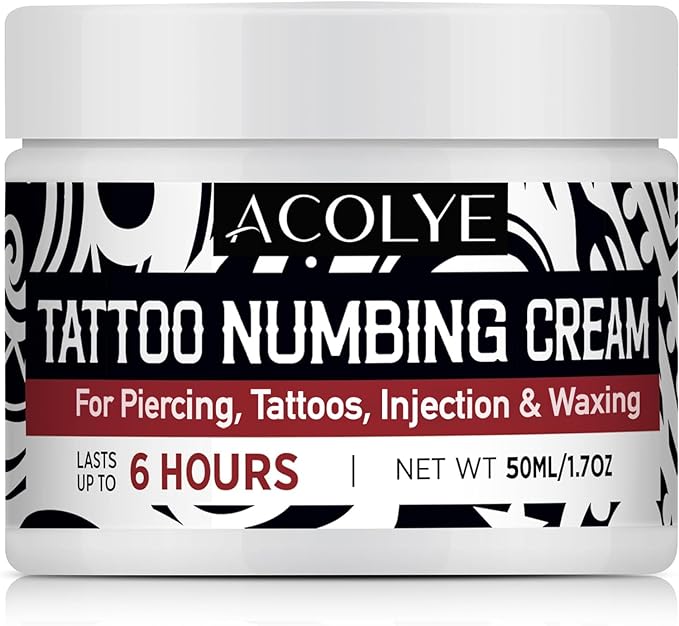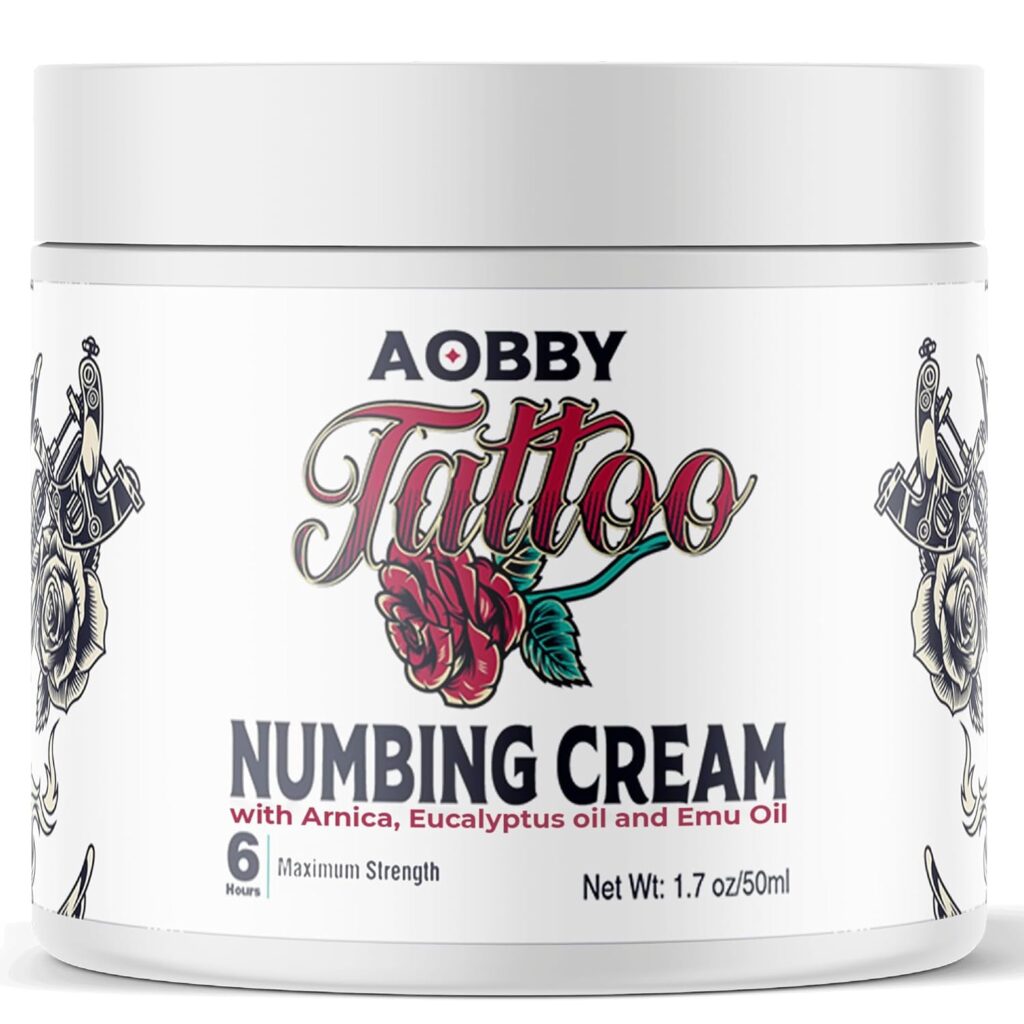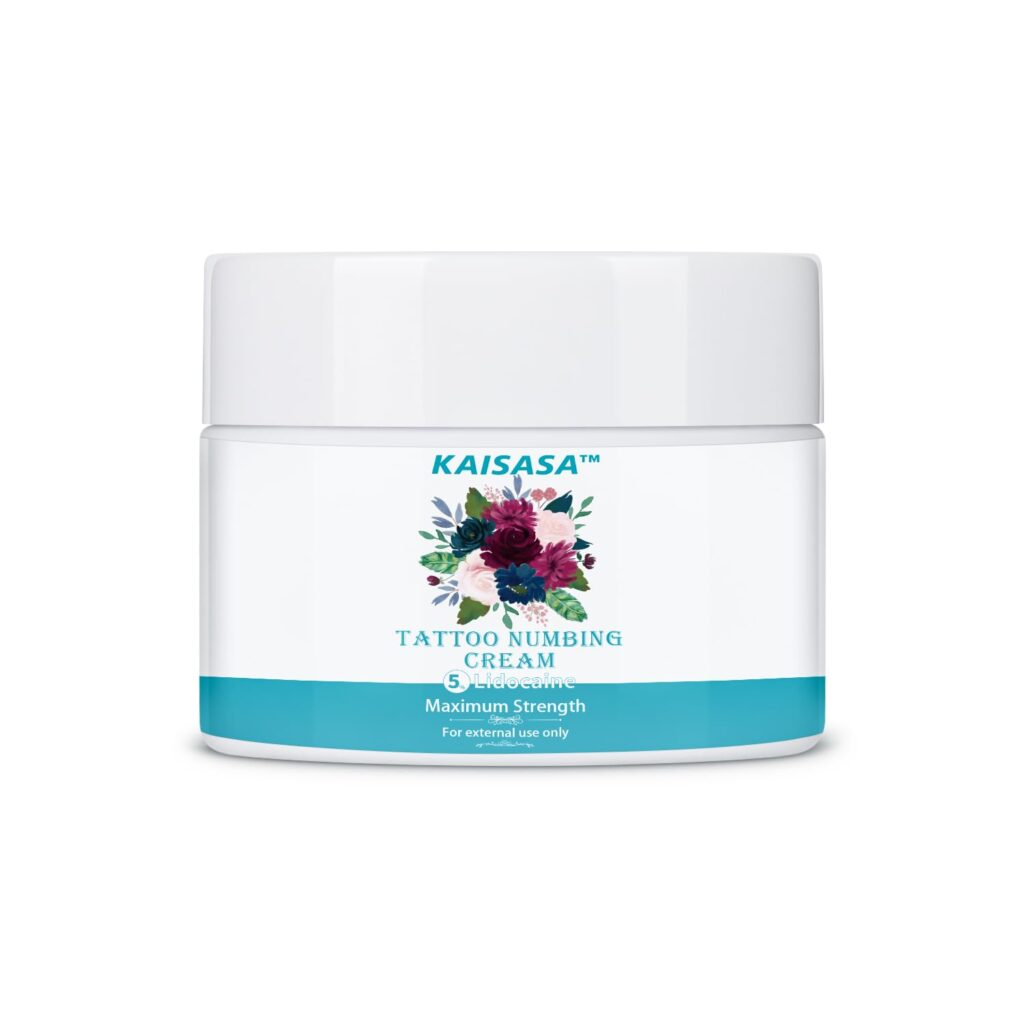Introduction:
Getting a tattoo can be both an exciting and nerve-wracking experience. While the level of pain varies for each individual, many people seek ways to minimize discomfort during the process. One popular method is using tattoo numbing creams. In this ultimate tattoo numbing cream guide: key facts to know post, we will delve into the world of tattoo numbing creams, exploring their benefits, ingredients, application techniques, potential side effects, and much more.
It is important to note that numbing sprays and gels may not provide complete pain relief, especially for more intense or prolonged tattoo sessions. Additionally, some tattoo artists prefer not to use them as they can affect the quality of the tattooing process. It is advisable to consult with your tattoo artist and follow their recommendations regarding numbing methods.
I. Understanding Tattoo Numbing Creams:
1. Pain reduction:
2. Enhanced comfort:
3. Increased tolerance:
4. Improved precision:
5. Reduced anxiety:
6. Extended tattoo sessions:
Overall, tattoo numbing creams are a valuable tool to ensure a more pleasant and painless tattooing experience
II. Types of Tattoo Numbing Creams:
1. Lidocaine-based Creams:
When applied to the skin, lidocaine penetrates the outer layer and reaches the nerve endings. It then inhibits the flow of sodium ions into the nerve cells, which prevents the generation and conduction of pain signals. By interrupting this communication, lidocaine effectively numbs the area, providing pain relief during the tattooing process.
It’s important to note that lidocaine should be used as directed and in appropriate concentrations. Excessive use or improper application can lead to adverse effects. It’s always recommended to consult with a professional tattoo artist or a healthcare provider before using lidocaine or any numbing cream.
1. Dr. Numb: Dr. Numb is a widely recognized numbing cream that contains 5% lidocaine. It is known for its fast-acting and long-lasting numbing effect, making it a popular choice among tattoo enthusiasts.
2. Numbify: Numbify is another popular lidocaine-based numbing cream that boasts a high concentration of 5% lidocaine. It is known for its quick absorption and extended numbing duration, providing reliable pain relief during tattoo sessions.
3. Hush Gel: Hush Gel is a lidocaine-based numbing gel that combines 4% lidocaine with botanical extracts to provide a soothing and numbing effect. It is often recommended for use before and during the tattooing process.
4. Bactine: is a lidocaine spray designed specifically for numbing the skin before tattoo procedures. With its 4% lidocaine formulation, this spray provides targeted and fast-acting pain relief.
Remember, it’s crucial to carefully follow the instructions and guidelines provided by the manufacturer when using any lidocaine-based tattoo numbing cream. Additionally, consult with your tattoo artist or a healthcare professional to ensure safe and proper usage
2. Benzocaine-based Creams:
Benzocaine works by temporarily blocking nerve signals in the area where it is applied, resulting in a numbing effect. It does this by inhibiting the function of voltage-gated sodium channels, which are responsible for the transmission of pain signals.
When benzocaine is applied to the skin, it penetrates the outer layer and reaches the nerve endings. It then binds to and blocks the sodium channels, preventing the influx of sodium ions into the nerve cells. This blockade interrupts the generation and conduction of pain signals, leading to temporary numbness in the area.
It’s important to note that benzocaine should be used as directed and in appropriate concentrations. Overuse or improper application can lead to side effects or adverse reactions. Before using any numbing cream containing benzocaine, it is advisable to consult with a professional tattoo artist or a healthcare provider to ensure its safe and proper usage.
While benzocaine is commonly used in various numbing creams, it may not be as prevalent in specifically tattoo numbing creams. However, there are some popular numbing creams that contain benzocaine as one of their active ingredients. Here are a few examples:
1. Tattoo Soothe:
Tattoo Soothe is a popular numbing cream that contains benzocaine along with other soothing ingredients. It is designed specifically for use during the tattooing process to provide temporary numbing and relief.
2. Numb Master:
Numb Master is a numbing cream that uses a combination of benzocaine and lidocaine for a strong numbing effect. It is commonly used for tattooing, piercing, and other skin procedures.
3. Uber Numb:
Uber Numb is a topical anesthetic cream that contains benzocaine as its primary active ingredient. It is often used for pain relief during tattooing, waxing, and other similar procedures.
It’s important to note that while these numbing creams may contain benzocaine, the specific concentration and formulation can vary. Always read and follow the instructions provided by the manufacturer and consult with a professional tattoo artist or a healthcare provider before using any numbing cream containing benzocaine.
3. Prilocaine-based Creams:
Prilocaine is a local anesthetic commonly used for its numbing properties. It belongs to the amide-type local anesthetics, similar to lidocaine and bupivacaine.
When applied or injected, prilocaine works by blocking nerve signals in the area where it is administered. It achieves this by inhibiting the function of voltage-gated sodium channels, which are responsible for the transmission of pain signals.
Prilocaine is often used topically or through injection to numb the skin and surrounding tissues. It is known for its rapid onset of action and relatively short duration of numbing effect compared to other local anesthetics.
One advantage of prilocaine is that it has a lower risk of causing allergic reactions compared to other local anesthetics. However, like any medication, it can still have side effects, including skin irritation, redness, or swelling at the application site.
It’s important to note that prilocaine should be used as directed and in appropriate concentrations. Consultation with a healthcare professional, such as a dermatologist or a healthcare provider with expertise in tattooing, is recommended to ensure safe and effective usage of prilocaine-based numbing creams.
1. Dr. Numb:
2. NumbSkin:
3. Super Numb:
It’s important to note that the specific concentration and formulation of these numbing creams can vary. Always read the instructions provided by the manufacturer and consult with a professional tattoo artist or a healthcare provider before using any prilocaine-based numbing cream.
III. Choosing the Right Tattoo Numbing Cream:
1. Factors to Consider:
Choosing the right tattoo numbing cream involves considering several factors, including:
The location and size of the tattoo can influence the level of discomfort experienced during the process. Areas with thinner skin or more nerve endings, such as the ribs or inner wrists, may be more sensitive. Larger tattoos may require longer periods of numbing.
Everyone’s pain tolerance varies. If you have a low pain tolerance or are nervous about the tattoo process, a stronger numbing cream or one that contains multiple active ingredients may be preferred.
It’s important to be aware of any allergies or sensitivities you may have to the ingredients in numbing creams. Read the product labels carefully and consult with a healthcare provider if you have any concerns.
Tattoo artists often have experience and insights regarding numbing creams. They may have recommendations based on their clients’ feedback or their own preferences. Discussing your options with the tattoo artist can help you make an informed decision.
It’s crucial to follow the instructions provided by the manufacturer and consult with a healthcare professional or tattoo artist before using any numbing cream. They can provide guidance based on your specific needs and ensure that the chosen numbing cream is safe and effective for your tattooing experience.
IV. Applying Tattoo Numbing Cream:
1. Preparations Before Application:
Before applying tattoo numbing cream, it is important to properly prepare your skin. Here are some steps to follow:
Start by cleaning the area where the tattoo will be applied. Use a gentle cleanser and warm water to remove any dirt, oils, or lotions from the skin. Gently pat the area dry with a clean towel. Exfoliating the skin with a gentle scrub or exfoliating brush can help remove dead skin cells and allow the numbing cream to penetrate more effectively.
To ensure you’re not allergic to the numbing cream, perform a patch test. Apply a small amount of the cream to a small area of skin, preferably on the inner forearm. Leave it on for the recommended duration, typically 30 minutes to an hour, and observe for any adverse reactions such as redness, itching, or swelling. If you experience any negative reactions, do not use the cream and seek medical advice.
2. Step-by-Step Application Process:
The timing of applying the numbing cream will depend on the specific instructions provided by the manufacturer. Generally, it is recommended to apply the cream approximately 30 minutes to an hour before your tattoo session. This allows enough time for the numbing agents to take effect.
Start by washing and drying the area where the tattoo will be placed. Then, using a clean spatula or your fingers, apply a thick and even layer of the numbing cream to the skin. Gently massage the cream into the skin for better absorption. This can help the numbing agents penetrate deeper into the skin. The amount of cream needed will vary depending on the size of the tattoo and the specific instructions provided with the cream. It is important to follow the recommended dosage to ensure effective numbing. After applying the cream, cover the area with plastic wrap or a bandage to help keep the cream in place and prevent it from drying out. This can also enhance the numbing effect by trapping heat.
– Arms and Legs:
Apply the cream in a circular motion, massaging it into the skin. Make sure to cover the entire area where the tattoo will be placed.
– Back and Chest:
If applying the cream to a larger area, consider dividing it into smaller sections to ensure complete coverage. Use gentle, circular motions to massage the cream into the skin.
– Face and Neck:
Be cautious and avoid getting the cream near the eyes, nose, or mouth. Apply a thin layer of cream to the desired area, being careful not to apply too close to delicate areas.
V. Potential Side Effects and Safety Precautions:
While numbing creams are generally safe to use, there are some potential side effects that you should be aware of. These may include:
– Skin irritation:
Some individuals may experience redness, itching, or a mild burning sensation at the application site. This is usually temporary and subsides within a few hours.
– Allergic reactions:
In rare cases, an allergic reaction to the ingredients in the numbing cream may occur. Symptoms may include severe itching, swelling, rash, or difficulty breathing. If you experience any of these symptoms, seek medical attention immediately.
– Numbness in unintended areas:
If the cream is not applied correctly or if excessive amounts are used, numbness may spread beyond the intended tattoo area. This can cause temporary loss of sensation in surrounding areas.
To ensure a safe application of tattoo numbing creams, consider the following precautions: – Patch test: Before applying the cream to a larger area, perform a patch test on a small section of your skin. This will help determine if you have any adverse reactions or allergies to the cream.
– Follow instructions:
Carefully read and follow the instructions provided with the numbing cream. Pay attention to recommended dosage, application techniques, and recommended duration of use.
– Avoid broken or irritated skin:
Do not apply numbing cream to broken or irritated skin, as it may increase the risk of side effects or introduce the cream into the bloodstream.
– Avoid eyes and mucous membranes:
Take care to prevent the cream from coming into contact with your eyes, nose, mouth, or other sensitive areas.
– Do not exceed recommended dosage:
Applying excessive amounts of numbing cream does not provide better results and can increase the risk of side effects. Stick to the recommended dosage.
– Inform your tattoo artist:
Let your tattoo artist know that you have used a numbing cream prior to the session. This will help them gauge your comfort level and make any necessary adjustments during the tattooing process.
If you have any pre-existing medical conditions, allergies, or concerns about using numbing creams, it is advisable to consult with a dermatologist or healthcare professional. They can provide personalized advice and ensure that numbing creams are safe for you to use. Additionally, your tattoo artist may have specific recommendations or guidelines for using numbing creams in conjunction with the tattooing process.
VI. Other Methods to Numb Tattoo Pain:
One effective way to manage tattoo pain is by distracting your mind from the sensation. You can try listening to music, watching a movie, or engaging in conversation with your tattoo artist or a friend. By diverting your attention, you may be able to reduce your perception of pain.
Non-prescription pain relievers such as acetaminophen (Tylenol) or ibuprofen (Advil) can help alleviate mild to moderate tattoo pain. It is important to follow the recommended dosage and consult with a healthcare professional if you have any underlying medical conditions or are taking other medications.
Similar to tattoo numbing creams, there are specific sprays and gels available that can help numb the skin during the tattooing process. These products usually contain lidocaine or benzocaine as active ingredients. It is essential to carefully read the instructions and follow the recommended application techniques.
VII. Aftercare and Post-Tattoo Care:
1. Cleaning the Tattoo:
It is crucial to keep your tattoo clean to prevent infection and promote proper healing. Here are some steps to follow:
i. Wash your hands thoroughly before touching the tattoo.
ii. Gently clean the tattooed area with lukewarm water and a mild, fragrance-free soap. Avoid using harsh or abrasive cleansers.
iii. Use your fingertips or a soft, clean cloth to gently pat the tattoo dry. Avoid rubbing or scrubbing the area, as it can cause irritation.
iv. Allow the tattoo to air dry for a few minutes before applying any aftercare products.
After cleaning the tattoo, you may need to apply a specific aftercare product to aid in the healing process. Some commonly recommended options include:
i. Tattoo-specific aftercare ointments or creams:
These products are specifically formulated to promote healing and protect the tattooed area. Look for ointments or creams that are free of fragrances, dyes, and irritants. Apply a thin layer of the product to the tattooed area, following the instructions provided.
ii. Non-fragranced moisturizers:
If you prefer not to use tattoo-specific aftercare products, you can opt for a gentle, non-fragranced moisturizer. Look for products that are free of irritants and suitable for sensitive skin. Apply a thin layer to keep the tattooed area moisturized and prevent dryness or cracking.
It is important to follow the instructions provided by your tattoo artist regarding aftercare and the use of specific products. They may have their preferred aftercare routine based on their experience and the type of tattoo you received. Additionally, avoid submerging your tattoo in water (such as swimming pools, hot tubs, or baths) until it is fully healed to reduce the risk of infection.
2. Moisturizing and Soothing:
Keeping your tattoo properly moisturized is crucial for the healing process. Moisturizing helps prevent the tattooed area from drying out, which can lead to cracking, scabbing, and potential damage to the tattoo. Moisturizers also help soothe any itching or discomfort associated with the healing process.
When choosing a moisturizer for your tattoo, it is important to opt for one that is gentle, non-fragranced, and free of irritants. Here are some suitable options:
i. Tattoo-specific aftercare ointments or creams:
As mentioned earlier, tattoo-specific aftercare products are designed to promote healing and protect the tattooed area. These products often contain ingredients like shea butter, beeswax, or vitamins that aid in the healing process.
ii. Unscented, non-comedogenic lotion:
If you prefer not to use tattoo-specific products, you can choose an unscented, non-comedogenic lotion. Look for a lotion that is suitable for sensitive skin and does not contain fragrances, dyes, or harsh chemicals. These lotions provide moisture without clogging the pores.
iii. Natural oils:
Some people find that using natural oils, such as coconut oil or jojoba oil, can be beneficial for moisturizing their tattoos. However, it is essential to ensure that you are not allergic to any specific oils and to patch test before applying them to your tattooed skin.
Remember to apply moisturizer to your tattooed area regularly, especially after cleaning or whenever the skin feels dry. However, be cautious not to over-moisturize, as excessive moisture can also hinder the healing process. Follow the instructions provided by your tattoo artist and listen to your body’s needs during the healing process.
3. Avoiding Irritants:
To ensure proper healing and minimize the risk of complications, it is important to avoid certain products that can irritate your tattooed skin. These include:
i. Fragranced products: Avoid using products with fragrances, as they often contain chemicals that can irritate the skin and potentially cause allergic reactions. This includes soaps, lotions, and body washes.
ii. Harsh cleansers: Stay away from harsh or abrasive cleansers that can strip the skin of its natural oils and disrupt the healing process. Opt for mild, fragrance-free soaps specifically formulated for sensitive skin.
iii. Alcohol-based products: Avoid using products that contain alcohol, such as toners or astringents, as they can dry out the skin and delay the healing process.
iv. Exfoliants: Refrain from using scrubs or exfoliating products on or near the tattooed area, as they can cause irritation or damage to the fresh tattoo.
During the healing process, it is essential to choose clothing that will not rub against or irritate your tattoo. Here are some tips:
i. Loose-fitting clothing:
Opt for loose-fitting garments made of soft, breathable fabrics like cotton. Tight clothing can rub against the tattoo and cause irritation.
ii. Avoid synthetic fabrics:
Synthetic fabrics like polyester or nylon can trap moisture and heat, potentially irritating the tattooed skin. Stick to natural fabrics that allow the skin to breathe.
iii. Be mindful of seams and tags:
Check your clothing for rough seams or tags that may rub against the tattooed area. If necessary, cut off tags or wear clothing inside out to minimize irritation.
iv. Choose comfortable underwear:
If your tattoo is located in an area that is covered by underwear, opt for comfortable and breathable cotton underwear to prevent unnecessary friction or irritation.
By avoiding irritants in products and making conscious clothing choices, you can help protect your tattoo and promote a smooth healing process. Always consult with your tattoo artist for specific instructions and recommendations tailored to your tattoo and skin type.
VIII. Frequently Asked Questions (FAQs) about Tattoo Numbing Creams:
Tattoo numbing creams, when used as directed, are generally considered safe. However, it’s important to follow the instructions provided by the manufacturer and consult with your tattoo artist or a healthcare professional before using any numbing cream to ensure it is safe for you. Some individuals may have allergies or sensitivities to certain ingredients, so it’s crucial to check the product’s ingredients list beforehand.
The duration of numbing effects can vary depending on the specific product used. Typically, numbing creams can provide relief for approximately 1 to 2 hours. However, the effectiveness may also depend on factors such as the thickness of the skin, the location of the tattoo, and individual tolerance levels. It’s best to consult with your tattoo artist for their recommendations on when to apply the numbing cream before the tattooing process.
Numbing creams can slightly affect the tattooing process. While they can help minimize discomfort, they may also reduce the sensation, making it harder for you to provide feedback to your tattoo artist during the procedure. It also tends to make the skin mushy. This can potentially impact the tattoo’s outcome. It’s important to communicate with your tattoo artist and let them know if you are using numbing cream, so they can make any necessary adjustments.
Age restrictions for using tattoo numbing creams can vary depending on the country and the specific product. Some numbing creams may have age restrictions due to the potential risks associated with certain ingredients. It’s essential to carefully read the product label and consult with a healthcare professional or the manufacturer if you are unsure about the age restrictions or suitability for a particular age group.
Tattoo numbing creams can generally be used on sensitive areas, but it’s crucial to exercise caution. Some areas, such as the face, neck, or genitals, may be more sensitive or have thinner skin. Always consult with your tattoo artist or a healthcare professional to ensure the numbing cream is safe for the specific area you intend to use it on. They can provide guidance on application techniques and any potential risks associated with sensitive areas.
IX. Final Thoughts:
Tattoo numbing creams can be a helpful tool in reducing tattoo pain and discomfort. However, it is crucial to choose a reputable brand, follow proper application techniques, and consult with professionals if needed. Remember, everyone’s pain tolerance and reaction to numbing creams may vary, so it’s important to find what works best for you. With the right approach and aftercare, your tattooing experience can be a more comfortable and enjoyable one.
Disclaimer: This guide is for informational purposes only and does not replace professional medical advice. Always consult with a healthcare professional before using any numbing creams or undergoing a tattoo procedure.
Top Rated Tattoo Numbing Creams.
Adellina Tattoo Numbing Cream Extra Strength.
Quickly numb targeted areas within 40-60 minutes, peaks after 15-25 minutes; lasts up to 6 hours.
Nupharmisto Maximum Strength Numbing Cream.
Provide up to 6 hours of numbing, and relief itching, soreness, burning, and reduce tattoo swelling
Acolye Tattoo Numbing Cream Extra Strength.
Plant based, Alcohol Free, Paraben free, Fragrance free. Multi Purpose, quick acting. up to 6 hrs
AOBBIY Tattoo Numbing Cream, Up to 6 Hours.
Painless tattooing without itching, soreness, or burning. Quick acting, safe ingredients, multi use.
Tattoo Numbing Cream, 50g Lidocaine with Emu Oil and Arnica.
Powerful healing ingredients, helping to soothe, moisturize, and heal your skin.
Tattoo Numbing Cream 5% Lidocaine, Maximum Strength.
Save and effective. Powerful sustainable ingredients. Up to 6 hours.
Tattoo Numbing Cream. 8 Hours Maximum Strength
FDA Approved. Advance Healing Ingredients. Safe Effective and Pure







